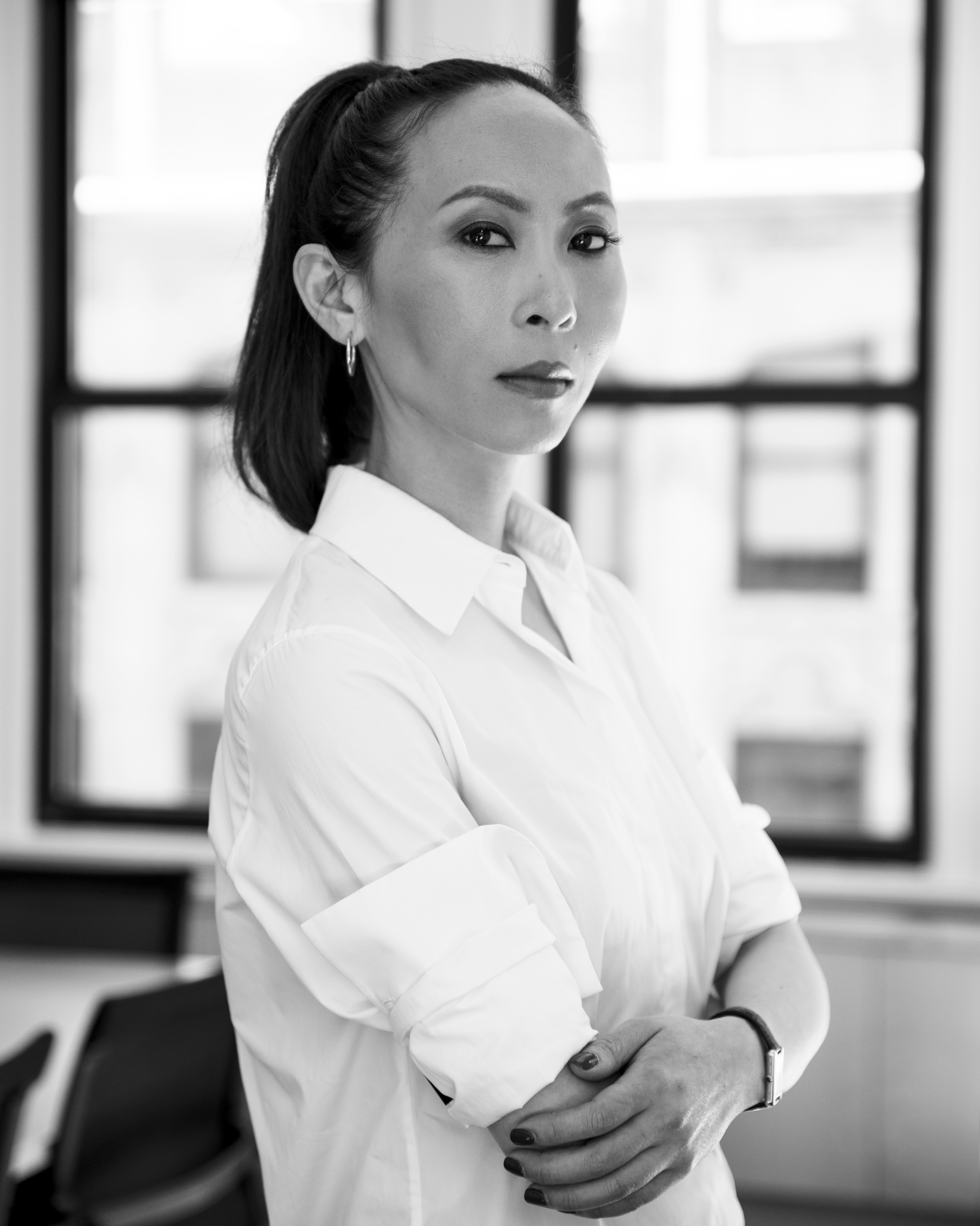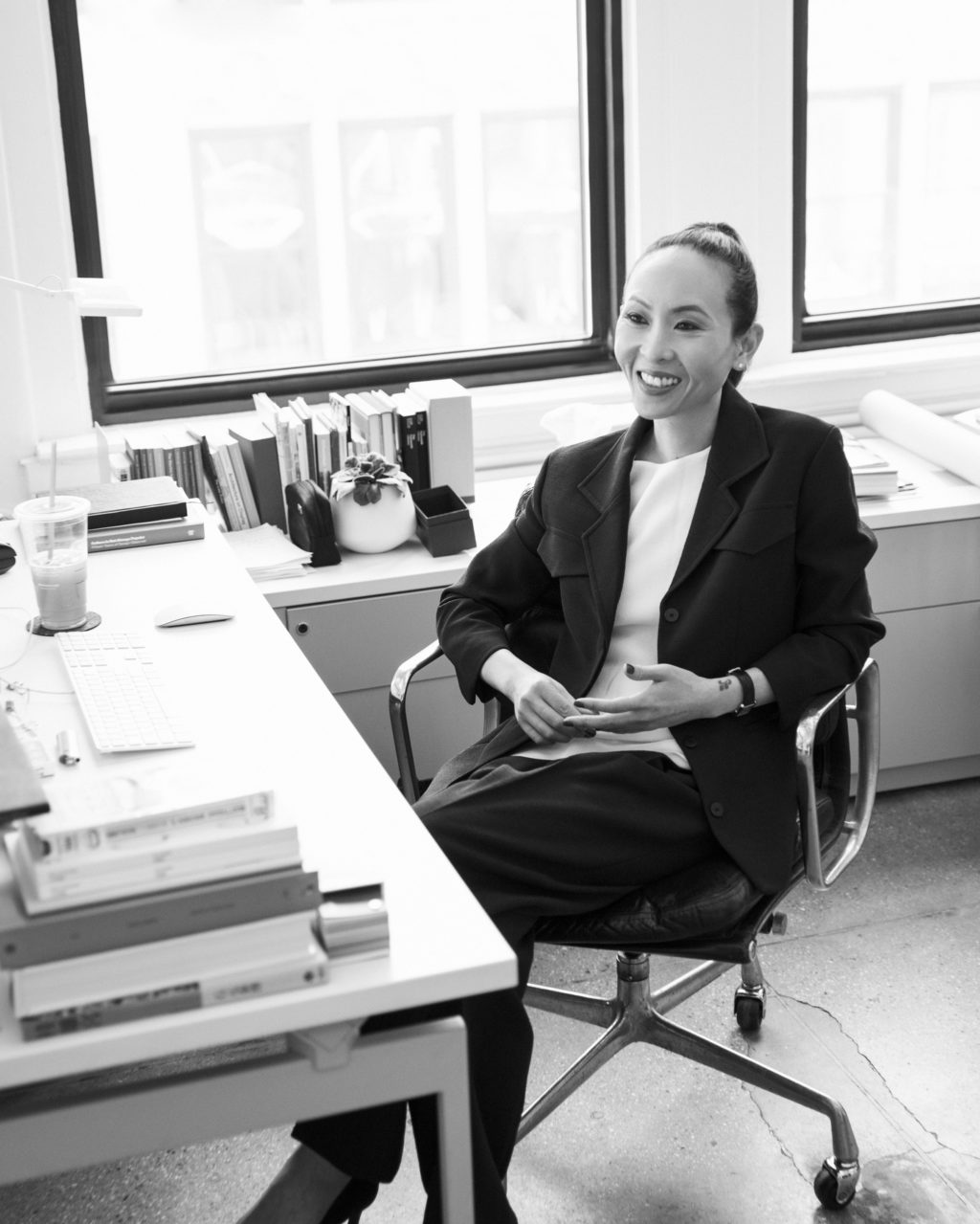Designer Natasha Jen Looks for the Sweet Spot Between ‘Inventive’ and ‘Appropriate’
June 21, 2019 | Filed in: Woman of the Week
Even if you don’t know who Natasha Jen is, you’ve almost certainly seen things she has made. In 2012, she became one of the youngest partners ever at Pentagram, arguably the world’s most prestigious design firm. She has since worked on iconic projects for clients like Nike, the Museum of Modern Art, and Kate Spade. And her ideas have major bottom-line results: After she recently oversaw the rebranding of ice cream company Van Leeuwen, its sales increased by 50 percent. We visited her at Pentagram’s office where she talked about respecting her own creativity, what she does when she hits a wall, and her most important morning ritual.

Natasha wears the Lauren top.
I GREW UP IN TAIWAN, WHERE PEOPLE ARE VERY RESPECTFUL of one another. The Taiwanese culture operates on collectivism—it’s all about considering others when you’re making a decision. It’s almost the opposite of American culture, which is so much about individualism. I came to New York for design school at 21, so I was already pretty formed. I went to the School of Visual Arts, and I now teach there. Many college students are all about self-expression, and that was an interesting clashing point for me. I came from a society where there’s no “you” unless you take care of other people, and I found Americans to be very self-centered. I have lived in the United States for 21 years, so I have become my own hybrid. But at first, I had a hard time. The ideals of collectivism still influence my work very strongly.
Want more M.M.? Sign up for our newsletter.
I WAS ONE OF THE TOP STUDENTS IN MY CLASS. That set a benchmark for me, regarding where I could possibly go after I graduated. My first job was at Sony music. It certainly isn’t a bad place, but it’s a large corporation that made a lot of compromises in the work itself. I realized pretty quickly that I was not going to be able to produce the work that would fulfill my own standards, so I left. After that, I started to look into studios that I identified as doing the very best, most boundary-pushing work, and that governed everything that I did from that point on.
PENTAGRAM WAS ALWAYS PIE IN THE SKY for me. It’s a legendary firm in the design world, and I never thought I would be invited to become a partner. When that happened, it was a big turning point for me. I was very intimidated as well as flattered. It’s a whole new and different standard. I don’t know if there’s ever an end to being intimidated when I come into work every day. I’m always trying to better myself and my work. That continual [drive] has underscored my experience here.

Natasha wears the Emalis jacket, the Sheela top, the Elliott trouser, the Lillian pumps, and the Pave earrings.
WITH EVERY PROJECT, WE HAVE TO ACCOMPLISH TWO DIFFERENT THINGS: Make something that is appropriate for the client and the product, but also make it inventive. To do something appropriate may not result in something inventive, and vice versa. It sets up an interesting dichotomy that we apply to everything we do. How do we push our ideas more toward the inventive side while being appropriate? Our conversations and critiques are all centered around this spectrum. It gives us a good framework for looking at our work.
WHEN AN IDEA ISN’T WORKING, I DON’T FIND IT HARD TO SAY SO. When creatives walk in the door here, they already know that they’re going to hear “no” or “this is not good enough” quite a bit. Still, it’s not easy to detach yourself emotionally from the work that you just gave birth to. If you can do that, it probably means that you don’t care about the thing you’ve created. The way that I deal with hearing “no” is to get into the “why.” Whoever is saying no, I’ll ask them, “Why are we doing this in the first place? Let’s zoom out, and not look at the work, and reestablish our objectives.” When the “why” is clearly understood, and everyone agrees on it, you have a better direction. And then you have a new objective and agenda that you can apply to more granular questions like, “Why are we reacting very negatively to this color?” A lot of people don’t have the vocabulary to talk about why they hate something. Sometimes, being a designer means functioning as a coach in that critical process.
WE NEVER PRESENT JUST ONE IDEA TO OUR CLIENTS. It’s always a range where some ideas are more expressive and others are a bit milder. Of course, we always get a range of reactions. Sometimes people are very happy, and sometimes they’re upset.

Natasha wears the Lauren top, the Elliott trouser, the Ginger pumps, and the Claressa earrings.
YOU CAN’T COERCE PEOPLE INTO [LIKING] WHAT THEY DON’T LIKE. I try to encourage clients to see what I see. It’s important that they see each component clearly and also see the components together as a whole. We usually have to help clients really look at the work and begin to identify which components that they feel need to be tweaked, or that they’re uncomfortable with. So it’s not that the whole thing doesn’t work—sometimes it may be about, say, the choice of typeface.
THE FIRST THING WE WANT TO DO WITH A NEW PROJECT is to understand its context as broadly and deeply as we can. Once we do that, then ideas will come up very naturally. I’m not the type of designer who likes to brainstorm in a group. Typically, idea generation happens on an individual basis. Everybody has their own way of doing it. Some of my designers may prefer to sit in front of a computer for three days, looking at references. Or they may just lock themselves in a room and start doodling, or take a walk. After we’ve all taken some time on our own, we will gather together to begin to talk about the ideas that we have. Then we can start eliminating ideas that are less strong, which helps us sharpen the others.
IDEAS ARE JUST CONNECTING DIFFERENT DOTS TOGETHER IN YOUR HEAD. I don’t have a linear way of working. I tend to write a lot of notes on my phone. I use the Evernote tool to accumulate my thoughts in a digitally accessible place. Over time, I’ve gathered a pretty big library of thoughts that I can revisit and search. Sometimes I’ll look through them randomly, and go through a folder that I may have created many years ago for a particular project. Sometimes I’ll say, “Wow, some of those things are actually relevant to what I’m working on now.”

Natasha wears the Emalis jacket, the Sheela top, and the Pave earrings.
I’VE ALWAYS LOVED TO DRAW AND MAKE THINGS. Graphic design was the most economically viable career in the field of visual arts, so this career was a very natural choice for me. But I’m always thinking about design across many different areas. A lot of our current work is still what most people think of as traditional graphic design—packaging design, book design. But I’m interested in designing other things as well, like spaces and objects. I think that once you have this creative tendency, it’s hard to corral it into one specific application. We always try to push the dimensionality of our work.
I DEFINITELY GO THROUGH PERIODS WHEN I’M UNINSPIRED. Or I’m discouraged by larger conditions, by where the industry’s going, by where the world’s going. When that happens, it always helps to refocus myself on the work I’m doing. The work itself is a living piece that we can impact. That’s where I have my control.
WHENEVER I REALLY HIT A WALL, I THINK ABOUT MY DAD. He passed away in 1998, as soon as I came here to New York for school. At the time, I didn’t realize how big his impact was on me, but now I realize how much he always respected my creativity. He encouraged me to do whatever I wanted, and of course, that involved many moments of derailment. But he allowed me to go through that process. He taught me to respect the idea of being free. I still have doubts about my career sometimes, even though I think I’m doing pretty okay. But whenever I have those doubts, I think about him. He never got to see all the work I have done, and what I have yet to do.

Natasha wears the Tamar blazer, the Giulia top, and the Foster pant.
I HAVE A COUPLE OF RITUALS EVERY DAY. In the morning, I get my Starbucks coffee first thing. I open my eyes, brush my teeth, and go get coffee. I place a mobile order when I’m in my apartment, and it takes about three minutes to walk to the nearest Starbucks. The people there know me. I get iced coffee, even in the winter. Then I go back to my apartment to finish getting ready for the day. I started practicing meditation recently, and it’s been very helpful, so I’ll do five minutes of meditation and then I’ll get dressed and come to work. The first people I talk to every day are my mom, my husband, and my two Shih Tzus. My mom lives with us.
WHEN I’M GETTING DRESSED IN THE MORNING, my outfit needs to be something that I can throw on as quickly as possible. That typically involves trousers or jeans and some sort of top. I have a range of pieces, from easy, minimalist T-shirts to things that are more expressive and colorful. With these two ends of the spectrum, I can mix and match a lot of my wardrobe. But the most important thing is that I cannot and do not want to spend too much time on it!
Photographs by Matthew Priestley. Styling by Chris Walsh.





